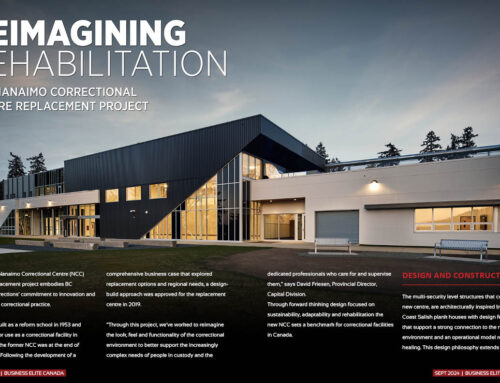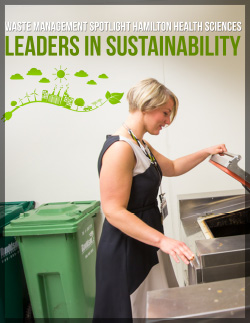Leaders in Sustainability
By Anna Guy
Hamilton Health Sciences is a community of 15,000 staff, physicians, researchers and volunteers that proudly serves southwestern Ontario residents, and provides specialized, advanced care to people from across the province. It is the only hospital in Ontario that cares for all ages, from pre-birth to end-of-life. As a world-leader in health care, Hamilton Health Sciences offers expertise in many areas, including cardiac and stroke care, cancer care, palliative care and pediatrics. In 2017/18 alone, over 52,000 patients were admitted, more than 4,000 babies were born, over 26,000 surgeries were performed and over 193,966 emergency and urgent care visits were made at HHS.
In addition to meeting the healthcare needs of its communities, Hamilton Health Sciences demonstrates an unwavering commitment to a healthier environment through sustainable practices that are grounded in ethical behaviour, regulatory compliance and financial accountability.
Environmental sustainability is a part of the transformation HHS is undergoing in order to obtain optimum efficiencies for its patients. HHS’s corporate environmental sustainability initiatives, through increased efficiencies, have born incredible cost savings that gets passed over to direct patient care. The three main programs and initiatives at the heart of this management system are: continuous energy conservation and demand management planning; annual waste audits and plans to reduce waste; and strenuous recycling efforts to minimize waste diversion.
“HHS is working hard to minimize our organization’s impact on the environment,” says Rob MacIsaac, President and CEO of Hamilton Health Sciences. “We have assembled a strong team of staff and professionals who drive efforts aimed at lowering our energy use and emissions, reducing waste and minimizing our water use.”
Cogeneration
Among that team is Chris Cuthbert, Energy and Cogeneration Manager, who oversees the operation and Maintenance of HHS’s three gas fired cogeneration plants and energy consumption in HHS’s six Hospital Sites. “Natural gas is the primary source of cogeneration. Producing our electricity on-site means our energy footprint is much lower than a traditional facility’s would be. We have a capacity of 22mw of electricity, or the equivalent of the power to run 3,600 homes a year, which is 80 to 90 per cent of our electrical needs throughout the year,” says Cuthbert.
This program has saved HHS $10 million annually and, in 2017 alone, HHS reduced over 1,700 metric tonnes of CO2e, the equivalent of taking 368 cars off the road for one year. However, the new Ontario government’s plans to cancel the Cap and Trade program will impact the effect the program has on HHS’s bottom line, says Cuthbert.
As waste management coordinator at HHS, Victoria Brzozowski has led a successful program to reduce HHS’s environmental footprint through implementing a recycling program in operating rooms (OR) and recycling and reduction of food waste in Nutrition Services.
Increasing Recycling Capacity
As waste management coordinator at HHS, Victoria Brzozowski has led a successful program to reduce HHS’s environmental footprint through implementing a recycling program in operating rooms (OR) and recycling and reduction of food waste in Nutrition Services.
A hospital setting has unique challenges for recycling due to biohazard contamination concerns which means that recycling cannot occur in all clinical areas of the hospital. In clinical areas approved for recycling, the staff require extensive education and operational supports (eg: signage, receptacles) to help them identify the specific recyclable materials in their respective clinical work areas. As an educational tool, some units are beginning to utilize a “3D recycling bulletin board (conceived by an OR Registered Nurse at the Hamilton General). This 3D board typically comprises of two columns—one for recycling and one for landfill—where examples of waste items generated in that specific work area are pinned appropriately, creating visual and physical references to what can and cannot be recycled. The board is created by front line staff with the support of the Waste Management Coordinator.
It’s a simple but highly effective educational tool, says Brzozowski, which, in conjunction with introducing a blue tint transparent bag for recyclable waste, has diverted an additional seven tonnes of OR recycling from landfills each month. “That amounts to 5 per cent more recycling a month,” says Brzozowski. “We are now trying to roll out this program throughout the organization because it has been such a great educational tool.”
Food for Thought
For more than a decade, HHS has been building a successful waste management, waste reduction and waste diversion program of its kitchen waste that diverts 180 tonnes of food waste from landfills each year. This is thanks to an exhaustive food packaging recycling program and food dehydrator system. “As an organization, we have changed our food service model entirely,” says Brzozowski. “We took it as an opportunity to look at how we are managing waste and our costs.”
The program had to be tailored for each individual site’s food services kitchen to account for differences in room size and layout, but once the staff got over the learning curve, the programs have run “like a well-oiled machine,” says Brzozowski. “We wanted to work within the staff work flow.”
Each site has a sorting station to separate patient food waste into three categories: landfill waste, food waste, and recycling. After sorting, the food waste is placed into a food dehydrator system which processes the material to reduce food waste volume by 80 percent, creating fine compost soil additive which is then processed through a green bin program. By reducing our food volume waste by 80 percent, HHS also reduces food waste cost by 80 per cent.
“Our nutrition services staff have also begun reusing the cardboard trays that patient meals are shipped on,” says Brzozowski. “Each tray carries 16 meals, and since it can be reused three to four times, it allows us to divert an additional 36 tonnes of cardboard from landfills each year.”
“Through waste management, resource consumption, and emissions reduction, there is an opportunity for cost savings,” says Cuthbert, “as well as environmental responsibility, social commitment, and financial stability. Though our areas are not direct patient care, it is indirect support activities, and an investment in improving efficiencies which free up funding for patient care.”
Adds Brzozowski, “HHS believes, and has shown, that an investment in efficiencies will drive down operation costs and increase our sustainability in the future.”







